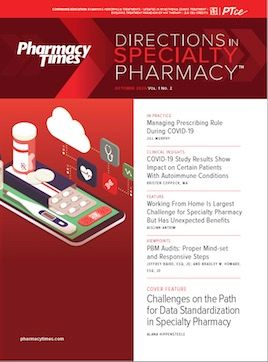Publication
Article
Specialty Pharmacy Times
Pharmacists Play a Critical Role in Managing HIV Care Changes During COVID-19
Author(s):
Key Takeaways
- HIV's impact expanded beyond initial perceptions, affecting minority communities significantly by the 2000s.
- Treatment advancements led to simplified regimens and reduced toxicity, with single-tablet regimens becoming standard.
The US Department of Health & Human Services released guidance at the beginning of the pandemic clarifying guidelines regarding best practices in HIV care.
Since the beginning of the HIV epidemic, approximately 33 million individuals have died from HIV/AIDS and 76 million have been infected with the virus, according to a session at the National Association of Specialty Pharmacy 2020 Annual Meeting & Expo Virtual Experience. During the session on the state of HIV care in 2020, Brandon Patchett, PharmD, AAHIVP, senior director of pharmacy of clinical services at the AIDS Healthcare Foundation, said that in the late 1980s and the 1990s, the virus was thought to affect only men who have sex with men. However, by the 2000s, the prevalence of the virus among minority communities was evident, according to Patchett.1
During the 2000s, an expansion of treatment options occurred, allowing for a simplification of regimens that continued into the 2010s, when treatment as prevention of the virus became the standard approach. In this period, single-tablet regimens became the standard of care, more tolerable antiretroviral treatments (ARTs) with decreased toxicity received approval, and patients began to grow older while living with HIV.1
In 2019, 1.1 million individuals were living with HIV in the United States, with 15,280 deaths related to HIV complications, which is a significant decrease in the annual mortality rate from the virus since the start of the epidemic.2
“In general, the numbers are slowly declining, but HIV remains a significant epidemic that we still need to keep our focus on,” Patchett said.
Following the global impact of coronavirus disease 2019 (COVID-19) on the health care system in 2020, Patchett said, some clear changes in HIV care have been implemented in the United States. The US Department of Health & Human Services released guidance at the beginning of the pandemic clarifying guidelines regarding best practices in HIV care.1
“Telephone, virtual visits, routine and nonurgent care, and adherence counseling really should be done over the phone versus a face-to-face encounter requirement. [For] persons for whom a regimen switch is planned, we can consider delaying the switch until close follow-up and monitoring are possible. For patients who are ill, we can consider telehealth options, including phone calls, or we can triage to a provider who may be able to manage the patient in person more effectively in some cases,” Patchett explained.
This switch to telehealth because of the COVID-19 pandemic has required providers to become more comfortable with connecting with patients in new ways, Patchett said. Methods of communication such as videoconferencing, patient portals, secure email contact, streaming media, electronic medical record systems, and wireless communication have become the norm in continuing to deliver care for patients with HIV.1
Patchett noted that a recent Houston Clinic study surveyed the acceptance of the switch to telehealth by patients with HIV. The results showed that 57% of respondents were more likely to use telehealth, if available, over in-person care. Additionally, 37% indicated they would use telehealth frequently or always as an alternative to clinic visits.1
The reasons cited for the telehealth preference included a better fit for patient schedules, a decrease in travel time, and more privacy. However, patients did note that they had concerns regarding the efficacy of a telehealth visit in meeting all their needs, as well as the security of their personal health information online.1
Patchett said that cost considerations are also ongoing for ART, which is the primary treatment for HIV. In 2018, ART was among the top 5 therapeutic classes in nondiscounted spending on medicine. Additionally, the overall cost of first-line ART regimens has increased more than 30% since 2012.3
“Overall, cost to the health care system, to insurers, and to society [is] significant, especially considering the increasing number of people who require lifelong antiretroviral therapy and experience rising drug costs,” Patchett said. “In general, out-of-pocket costs for patients can be a barrier to the initiation and continuation of therapy. [We] as pharmacists play such a critical role when it comes to navigating…these potential barriers and cost considerations for patients.”
REFERENCES
- Patchett B. State of care 2020: HIV. Presented at: National Association of Specialty Pharmacy 2020 Annual Meeting & Expo Virtual Experience; September 14-18, 2020. Accessed September 15, 2020. https://nasp.6connex.com/event/VirtualExperience/en-us#!/Lobby
- US Department of Health & Human Services. Policies and Issues: HIV Care Continuum. HIV.gov. Updated March 26, 2020. Accessed September 22, 2020. https://www.hiv.gov/federal-response/policies-issues/hiv-aids-care-continuum
- IQVIA Institute. Medicine Use and Spending in the U.S.: A Review of 2018 and Outlook to 2023. Published May 9, 2019.






